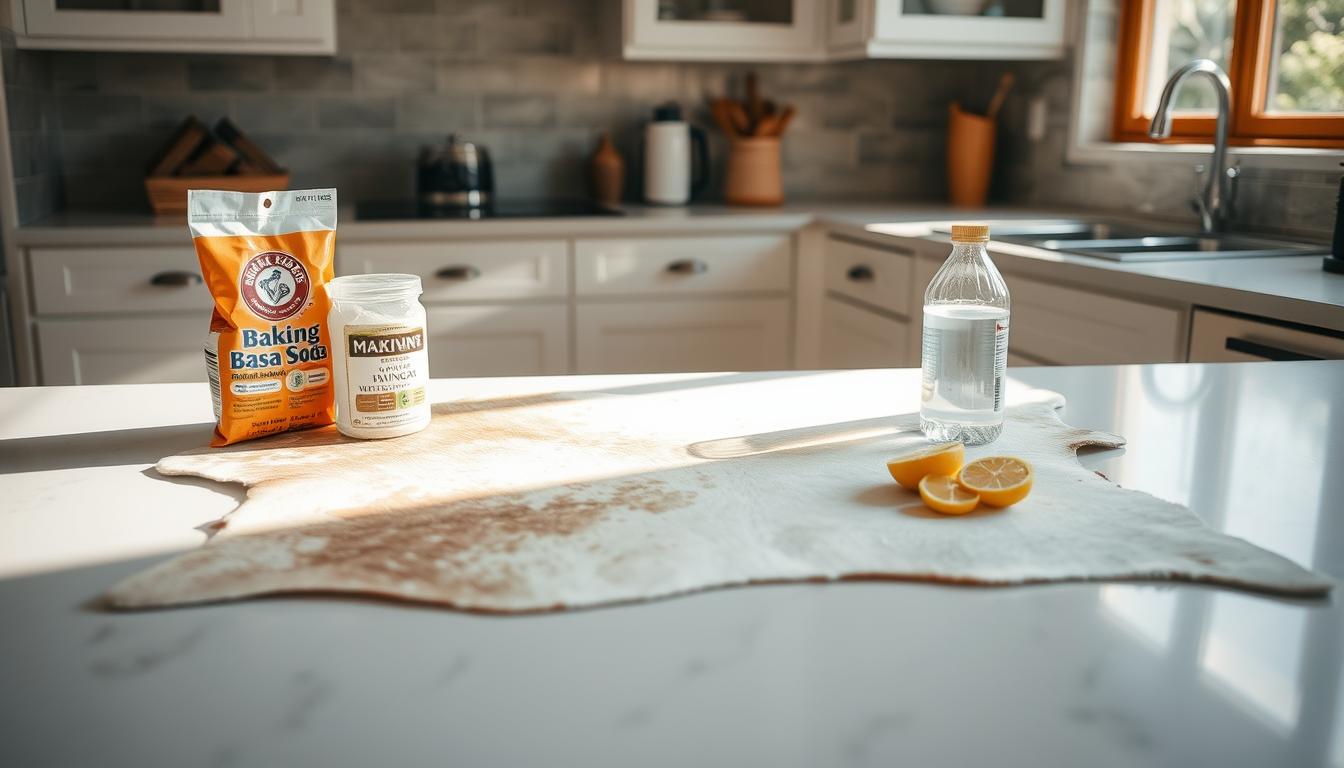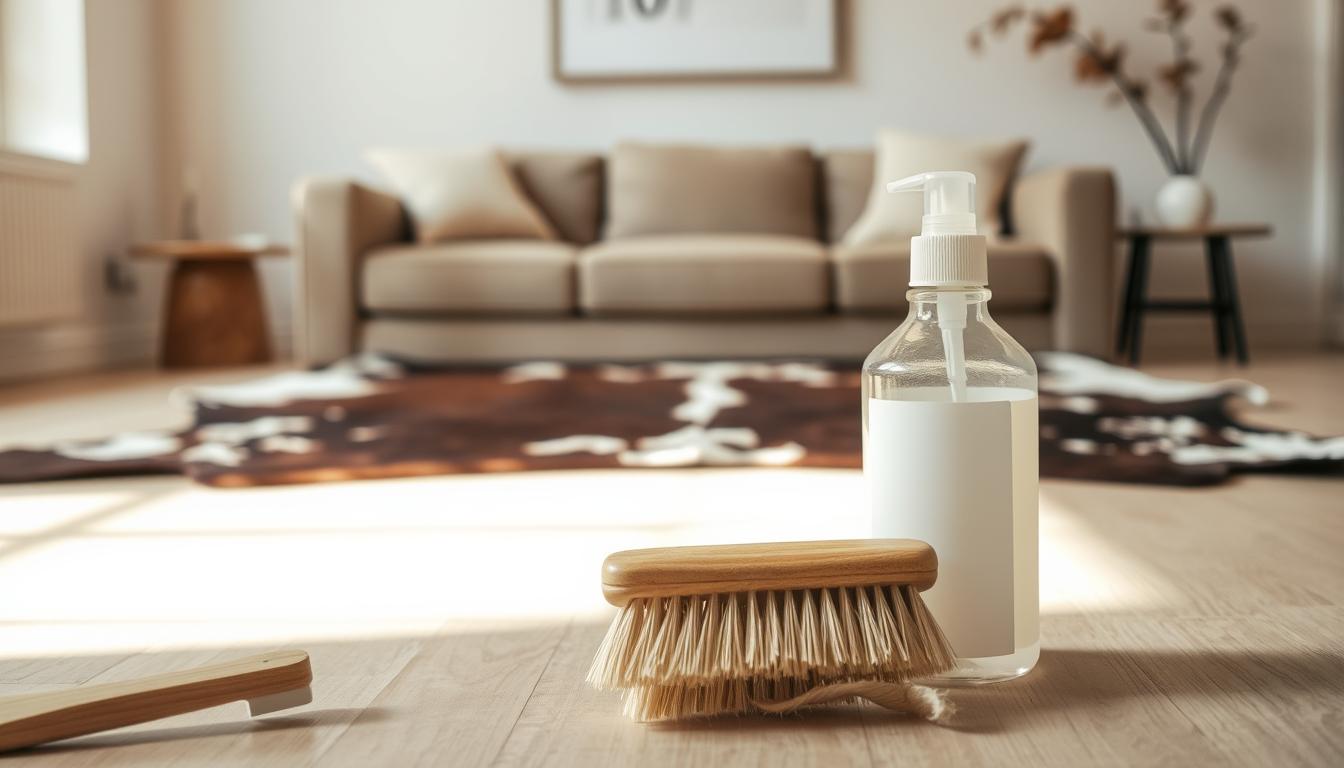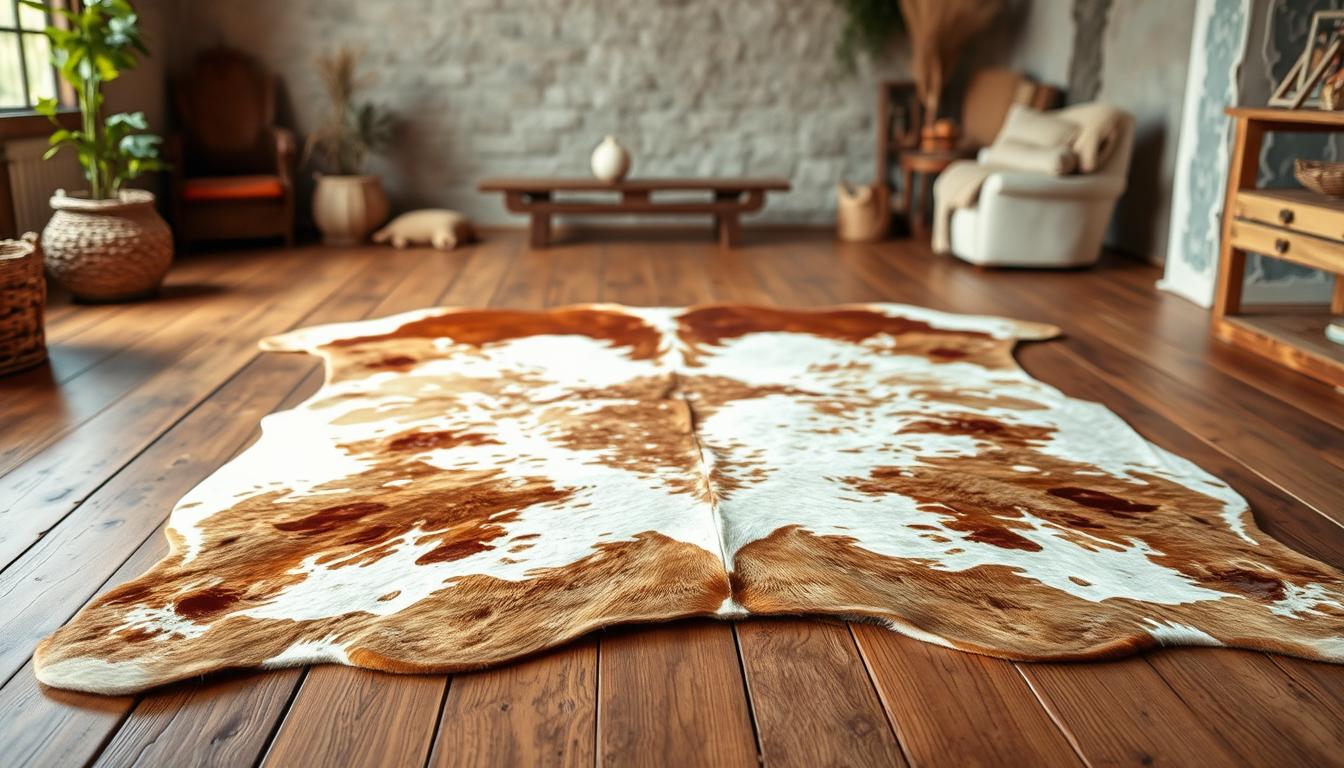
Cowhide Rug Smell: 5 Ways to Remove Odor Naturally
You’ve chosen a beautiful, earthy decor piece to elevate your space. But instead of subtle sophistication, you’re greeted with an unexpected leather-like scent that lingers. Is this normal, or does it signal something’s wrong with your prized furnishing?

Authentic animal hides carry a distinct aroma—a hallmark of quality craftsmanship. The fresh, earthy notes you detect are part of their organic charm. However, sharp chemical undertones or overpowering perfumed smells tell a different story. These could mean rushed tanning processes or low-grade treatments that compromise both air quality and durability.
This guide reveals how to distinguish between harmless natural scents and warning signs in your decor. You’ll learn five simple, non-toxic strategies using everyday items from your pantry or cleaning cabinet. From baking soda’s absorption power to sunlight’s purifying effects, these methods protect your investment while keeping your home fresh.
Key Takeaways
- Natural leather-like scents indicate quality craftsmanship in authentic hides
- Chemical or perfumed odors may reveal subpar tanning processes
- Common household items effectively neutralize unwanted aromas
- Proper care prevents odor recurrence without damaging materials
- Sunlight and airflow serve as powerful natural deodorizers
Introduction to Cowhide Rug Smell
When you bring home a natural floor covering, its earthy character comes with a story written in every fiber. These pieces aren’t mass-produced textiles—they’re preserved organic materials that once protected living animals. Their resilience and texture make them stand apart from synthetic alternatives.
What Makes These Natural Floor Coverings Unique
Unlike processed fabrics, authentic hides retain their original hair patterns and skin texture. They’re crafted from by-products of food production, giving them eco-friendly credentials many homeowners appreciate. The water-resistant qualities you notice? That’s nature’s design—developed over years to shield the animal from harsh elements.
Gentle Approaches for Freshness
Organic materials demand thoughtful care. Harsh chemicals strip away natural oils, but simple pantry staples lift odors without damage. Sunlight becomes your ally here, working with airflow to neutralize unwanted scents while preserving the hide’s integrity.
These methods align with the material’s origins—using nature’s own tools to maintain its beauty. You’ll protect your investment and keep your space inviting through strategies that respect the product’s lifecycle.
Understanding Why Cowhide Rugs Smell
That distinctive aroma when unboxing your new decor piece isn’t accidental—it’s chemistry at work. Premium natural floor coverings develop their character through meticulous cleaning and preservation methods. Let’s decode what creates these scents and how to interpret them.

The Role of Tanning Chemicals
Artisans use tanning solutions to transform raw animal skins into durable home accents. Quality products employ vegetable-based tannins that leave a mild, earthy fragrance—like premium leather goods. Budget alternatives often rely on synthetic chemicals that emit sharp odors resembling industrial adhesives.
High-grade processing removes excess residues through repeated rinsing. If your piece smells like a hardware store aisle, it likely skipped crucial treatment stages. These shortcuts compromise both air quality and material longevity.
Natural Characteristics and Initial Odors
Untreated hides retain natural oils that interact with tannins during production. This creates subtle musky notes many associate with luxury craftsmanship. Pieces retaining their original hair layers amplify these scents due to trapped organic compounds.
| Process Type | Scent Profile | Durability |
|---|---|---|
| Vegetable Tanning | Earthy, subtle | 15+ years |
| Chrome Tanning | Metallic, pungent | 5-8 years |
| Synthetic Treatments | Chemical, acidic | 2-3 years |
Personal sensitivity plays a role too. While some relish the authenticity of these aromas, others find them intense initially. Proper air circulation typically softens the scent within weeks, revealing the material’s true character.
Effective Natural Methods to Eliminate Cowhide rug smell
Fresh decor should enhance your space, not overwhelm it. If your new natural hide carries stronger notes than expected, try these gentle techniques to restore balance. Each approach respects the material’s organic origins while tackling odors at their source.
Five proven strategies work with nature’s chemistry rather than against it. Unlike harsh solvents that strip protective oils, these solutions maintain integrity while neutralizing aromas. They’re safer for households with children or pets and often cost less than professional services.
| Method | Effectiveness | Cost | Time Required |
|---|---|---|---|
| Air Circulation | High (surface odors) | Free | 24-48 hours |
| Baking Soda | Moderate (embedded scents) | $2-$5 | 6-8 hours |
| Activated Charcoal | High (persistent smells) | $10-$15 | 3-5 days |
Start with preventive measures—just as you’d wash new linens. Lay your piece outdoors on a dry, breezy day. Rotate it periodically to expose all surfaces. For deeper issues, sprinkle food-grade baking soda lightly across the hide before brushing it off.
Charcoal bags placed beneath the material absorb stubborn odors silently. These techniques adapt to your needs—whether addressing factory residues or environmental smells. Regular maintenance keeps your decor fresh for years without compromising its natural beauty.
Air Out Your Cowhide Rug for Freshness
Fresh air works wonders for more than just your mood—it's nature's most effective deodorizer. Natural materials thrive when exposed to airflow and sunlight, which work synergistically to break down organic compounds causing unwanted scents.
Benefits of Sunlight and Ventilation
UV rays act as natural disinfectants while gentle breezes carry away trapped odors. This dynamic duo:
- Neutralizes tannin residues without chemicals
- Preserves hair texture through gradual drying
- Prevents mustiness by reducing moisture retention
"Rotate your piece every 2 hours for even exposure—morning sunlight is gentlest on natural fibers."
Practical Tips for Air Drying
Winter challenges require smart solutions. Position your decor in shaded outdoor areas protected from precipitation. For indoor ventilation:
- Use sturdy hangers or a clean clothesline
- Place near open windows with cross-breezes
- Limit exposure to 2-4 hours initially
Newly treated pieces may need multiple sessions. If scents linger overnight, repeat the process—patience yields better results than harsh treatments. For maintenance between airings, follow our natural care protocol to preserve material integrity.
Utilizing Baking Soda and Other Natural Cleaners
Transform your cleaning routine with pantry staples that tackle odors while protecting natural fibers. These kitchen heroes work silently without synthetic fragrances or harmful residues.
Application Techniques and Safety Tips
Baking soda outperforms commercial deodorizers by absorbing odors at their source. Sprinkle it evenly across the surface using a fine-mesh strainer. Let it sit for 2+ hours—this waiting period allows the powder to trap odor molecules effectively.
Vacuum thoroughly using an upholstery attachment. Move slowly in overlapping strokes to capture every grain. Leftover residue can dull the material's natural sheen over time.
For grease marks or food spills:
- Cover stains completely with cornstarch
- Let it clump as it absorbs oils (2 hours minimum)
- Brush gently before vacuuming
These methods prove safer than chemical cleaners—no toxic fumes or skin irritants. Always test a small hidden area first. Natural materials vary in porosity, and excessive moisture can cause stiffness.
"A stiff-bristle brush helps work powders deeper into textured surfaces without damaging hairs."
Store leftover baking soda in airtight containers to maintain freshness. Combine with essential oils for light scenting if desired, though pure applications work best for stubborn odors.
Gentle Cleaning Techniques to Preserve Your Rug's Quality
Natural hide decor demands specialized care to maintain its luxurious texture. Unlike synthetic carpets, these pieces retain organic oils that protect their surface but require mindful cleaning approaches. Their durable hair layer resists light spills, yet prompt attention prevents permanent marks.

For stubborn stains, animal-specific shampoos work best. Mix 3 drops with cool water in a spray bottle—test this solution on a hidden area first. Blot spills immediately using a microfiber cloth, working from the edge inward to prevent spreading.
Three rules protect your decor:
- Never soak the material—dampen cloths instead of spraying directly
- Brush hairs gently with a soft-bristle tool to lift dirt
- Dry flat away from heat sources to avoid warping
Excess moisture causes shrinkage and stiffening. After cleaning, press a dry towel against damp areas to absorb residual water. Rotate the piece periodically during drying to ensure even airflow. For dust removal between cleanings, use a handheld vacuum on low suction.
"Treat stains like spilled wine—blot, don’t rub. Aggressive scrubbing separates hair follicles from the hide."
Regular maintenance preserves flexibility and prevents cracking. Store cleaning supplies in labeled containers to avoid mix-ups with harsh chemicals. With proper care, your natural decor matures gracefully, developing richer patinas over time.
Deep Clean and Maintenance Solutions
Revitalizing your natural floor covering requires methods that balance thoroughness with material preservation. Steam emerges as the ultimate ally here—penetrating fibers without harsh scrubbing or excessive moisture.
Steps for a Deep Clean Without Damage
Handheld steamers designed for curtains or clothing work surprisingly well for this task. Many hardware stores rent professional-grade units for under $20/day if you need heavier power. Always test a small hidden area first to ensure heat tolerance.
Effective steam cleaning follows three rules:
- Maintain 6-8 inch distance to prevent overheating
- Move the nozzle in the hair’s natural growth direction
- Limit sessions to 10-minute intervals for even drying
The process eliminates bacteria trapped beneath the surface while lifting embedded odors. Post-treatment, hang your piece in a shaded outdoor area or near fans. Proper airflow prevents moisture buildup that could lead to stiffness.
"Low-temperature settings preserve natural oils—high heat causes shrinkage and texture damage."
For ongoing care between deep cleans, follow our natural care protocol. This prevents dirt accumulation while maintaining the material’s supple feel. Regular maintenance reduces the need for intensive cleaning sessions.
Preventing Odor Recurrence with Routine Care
Maintaining your cowhide rug’s freshness requires consistent attention to its unique needs. Regular upkeep not only prevents unwanted aromas but also preserves the material’s luxurious texture over time.
Essential Maintenance Habits
Start by taking your rug outdoors weekly for a vigorous shake. This simple action dislodges dust particles trapped between natural fibers that vacuuming might miss. Focus on corners where debris accumulates.
Every two weeks, use a soft-bristled brush to comb through the hairs. Work in their growth direction to lift embedded dirt gently. Follow with thorough vacuuming using an upholstery attachment.
For ongoing freshness:
- Apply natural deodorizing powder monthly
- Address spills immediately with dry cloths
- Rotate rugs quarterly to ensure even wear
These practices extend your cowhide rug’s lifespan while keeping spaces inviting. Pair them with seasonal deep cleaning for comprehensive care that honors organic origins.
FAQ
Why do natural hair rugs develop odors over time?
The tanning process uses chemicals that may leave residues. Natural oils in the hide can also break down, releasing smells. Proper care minimizes this.
Can sunlight help eliminate lingering odors?
Yes! UV rays neutralize bacteria. Place the item outdoors for 2–3 hours, flipping it halfway. Avoid prolonged exposure to prevent fading.
How does baking soda remove unwanted smells?
Sprinkle it evenly, let sit overnight, then vacuum. This absorbs odors without harsh chemicals. Combine with white vinegar for stubborn cases.
What’s the safest way to clean spills without damage?
Blot immediately with a microfiber cloth. Use a damp towel and mild soap, working in the hair’s direction. Never soak the area to preserve texture.
How often should I deep clean my natural hair decor?
Every 6–12 months, depending on use. Steam cleaning or specialized cleaners work well. Always test methods in an inconspicuous area first.
Can routine maintenance prevent future odor issues?
Shake debris weekly and vacuum monthly. Address spills promptly. Rotate the piece to ensure even wear and airflow.









